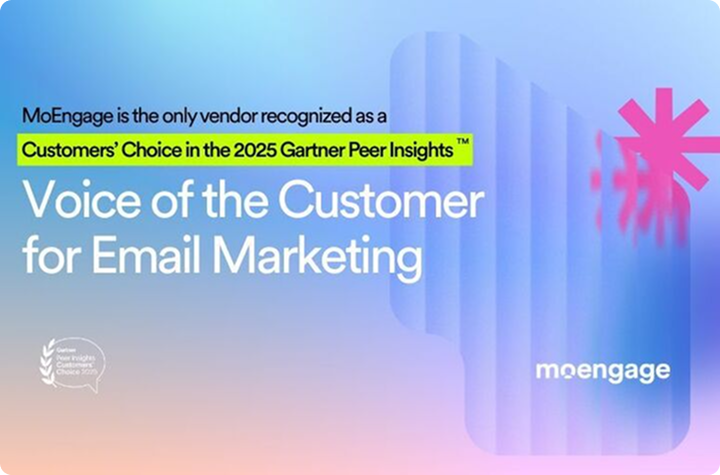Customer Engagement Deep Dive: How to Build Personalized Cross-Channel Journeys
Learn More
Are you running out of ‘data-credits’ quickly when you attempt real-time data unification?
Is your ‘ecosystem’ vendor hiding details about implementation timelines, the need for mandatory specialized partners, maintenance costs, and future upgrade fees?
Are you spending heavily to activate your data and even more to ‘store’ your data?


❌ Fragmented customer experiences despite having a CDP?
❌ Slow campaign activation and lack of real-time capabilities?
❌ Difficulty proving ROI to your finance team?
❌ Focusing on data collection instead of actionable, real-time insights?




What is a CDP? And why are many brands moving away from CDPs in 2025?
Before the advent of a warehouse-centric data view, marketers were in absolute chaos. Customer data was scattered across multiple isolated tools: email, platforms, CRM systems, websites, mobile apps, call centers, and point-of-sale systems. All of these tools were part of the puzzle, but alone, they wouldn’t help brands with a 360-degree view of their customers.
In this scenario, the customer data platform (CDP) became a potential solution in 2013.
CDPs could:
1) Collect and ingest data from various sources.
2) Unify data by stitching together identifiers from various sources to build a single customer profile.
3)Segment customers based on attributes, behavior, and affinities.
4) Activate data by sending data to marketing and advertising tools to build targeted campaigns.
In theory, CDPs helped marketers make sense of the data and interact with customers in a contextual, relevant, and timely manner.
But, in 2025, are CDPs keeping up with the times, especially in a warehouse-centric world?
The traditional CDPs pose many challenges to marketers, which include:
Data duplication and silos: CDPs sometimes create a copy of customer data that already exists in the data warehouse, resulting in data duplication. This also adds to the silos while increasing storage costs.
Incomplete picture: CDPs primarily ingest marketing data, which makes it challenging to build the complete picture. The data stored in the warehouse includes long-term purchase history, inventory updates, insights from product interactions, support tickets, and call center details, thereby becoming more instrumental in building a complete customer profile vs a CDP.
Latency issues: Ensuring that the CDP is synced in real time with the single source of truth (SSOT) can be challenging, resulting in campaigns that are not exactly real-time.
My current enterprise customer engagement vendor has been persistently asking me to purchase their data cloud solution. Any tips on how to decide if this is the right choice?
Behind their presentations that oversimplify your data challenges, legacy martech tools are notorious for selling data management solutions that:
⛳They have an ecosystem lock-in strategy.
Focusing on integrations within their own product suites makes it difficult and costly to use outside tools. This is their tactic to pressure you to keep buying more from them.
💡Cross-compatibility and vendor neutrality should be a key focus when you choose a data management solution.
⛳They have high entry costs and constantly upsell.
If the base platform costs you heavily and you need numerous expensive add-ons to do even the basic engagement tasks, you must ‘upgrade’ to the latest version of all marketing tools before you can access their data cloud….isn’t something sus?
💡 Any addition or modification to your martech stack must consider the TCO (total cost of ownership).
⛳They love to downplay the Total Cost of Ownership (TCO).
If you are not getting concrete answers about implementation timelines, the need for mandatory specialized partners, maintenance costs, and future upgrade fees, you must find a better vendor.
Additionally, if the pricing model is based on ‘data credits,’ you might pay much more than you should.
💡Why pay more than you should when you don’t even get the basics like implementation support and real-time data integration?
⛳They try to sell you a dream while ignoring your concerns.
They talk ‘data’ a lot but ask them the hard questions about on-ground complexities, concerns about integrations, and resource requirements; they seem too eager to gloss over and close the ‘deal’.
I have a CDP and my martech stacks seems to be working fine. What are some ways in which I can measure if my current CDP is adding value?
If your answer is a NO to any of these questions, you’d have to re-evaluate your current CDP.
– Has there been an increase in customer lifetime value (CLV), retention rates, and revenue per customer after installing a CDP?
– Has a consistent increase in campaign performance metrics, customer loyalty, and conversion rates been observed after installing a CDP?
– Has there been an increase in your customer satisfaction (CSAT) scores and positive reviews?



MoEngage is an insights-led platform trusted by 1,350+ global brands like McAfee, Flipkart, Domino’s, Nestle, Deutsche Telekom, and more. MoEngage’s powerful analytics, personalization, and AI capabilities give a 360-degree view of your customers and help you create journeys across digital channels.
© Copyright 2025 MoEngage. All Rights Reserved.

Please wait while you are redirected to the right page...
